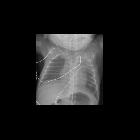umbilical venous catheters

















Umbilical venous catheters (UVCs) are commonly used in neonates for vascular access and should be carefully assessed for position on all neonatal films.
Position
An umbilical venous catheter generally passes directly superiorly and remains relatively anterior in the abdomen. It passes through the umbilicus, umbilical vein, left portal vein, ductus venosus, middle or left hepatic vein, and into the inferior vena cava.
The tip should lie at the junction of the inferior vena cava with the right atrium.
Anomalous positioning
Anomalous positioning of the umbilical venous catheters is quite frequent. The catheters are inserted by the pediatrician without imaging guidance, and given the small size of infants (especially those requiring umbilical catheters), a small variation in length of catheter can result in significant malpositioning (too long). Alternatively, the catheter may not travel along the intended route (wrong turn).
Too long
If the umbilical venous catheter is advanced too far along its intended course, the tip may end up in a number of locations:
- pulmonary vein
- left ventricle
- superior vena cava
- right ventricle
Wrong turn
If the umbilical venous catheter reaches the left portal vein but does not continue into the ductus venosus, the catheter can travel left into the more peripheral left portal vein or right, where it can eventually course into the right portal vein or hepatofugally into the main portal vein (or potentially farther into the vessels that merge to form the portal vein: the superior mesenteric and splenic veins). Malpositioning within the portal venous system is associated with portal vein thrombosis.
Complications
Some complications can occur in a well-positioned catheter. The most common of these is formation of thrombus along the catheter.
Malpositioned catheters may result in structural injury including:
- hepatic hematoma from perforation of an intrahepatic vascular wall
- pericardiac hematoma from perforation of the right or left atrial wall
See also
- umbilical arterial catheters: the umbilical arteries initially course caudally to enter the right and left iliac arteries
Siehe auch:
- Vena cava inferior
- Nabelarterienkatheter
- Komplikationen Nabelvenenkatheter
- high malposition of the umbilical venous catheter
- korrekte Position Nabelvenenkatheter
und weiter:

 Assoziationen und Differentialdiagnosen zu Nabelvenenkatheter:
Assoziationen und Differentialdiagnosen zu Nabelvenenkatheter:


